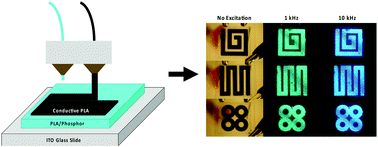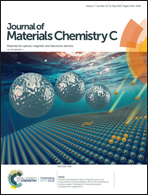3D-Printed alternating current electroluminescent devices†
Abstract
This work explores the use of metal-doped zinc sulfide (ZnS) phosphor materials by harnessing their unique optical response for the development of 3D-printed electroluminescent devices. Through materials design and processing considerations, the ability to manufacture alternating current electroluminescent (ACEL) devices using commercially available fused deposition modeling (FDM) type 3D printing systems is demonstrated. ZnS-based phosphors are incorporated within a polylactic acid (PLA) host matrix and fabricated by depositing a single layer (100 μm) of PLA/phosphor-functionalized filament onto an ITO-coated glass slide, sandwiched between a second electrode comprising of 3D-printed carbon-doped conductive PLA. By applying a voltage across the PLA/phosphor layer, 3D-printed ACEL devices display a tunable bright blue/green luminescent behavior. The observed optical response is highly reproducible and dependent on both the applied voltage and frequency of excitation, where the recorded emission displays a significant blue shift with increasing excitation frequencies. ACEL devices with various geometric shapes are printed to further demonstrate the effectiveness and feasibility of additive manufacturing and 3D printing technologies as an additional methodology and approach for developing custom light emitting devices and displays.



 Please wait while we load your content...
Please wait while we load your content...